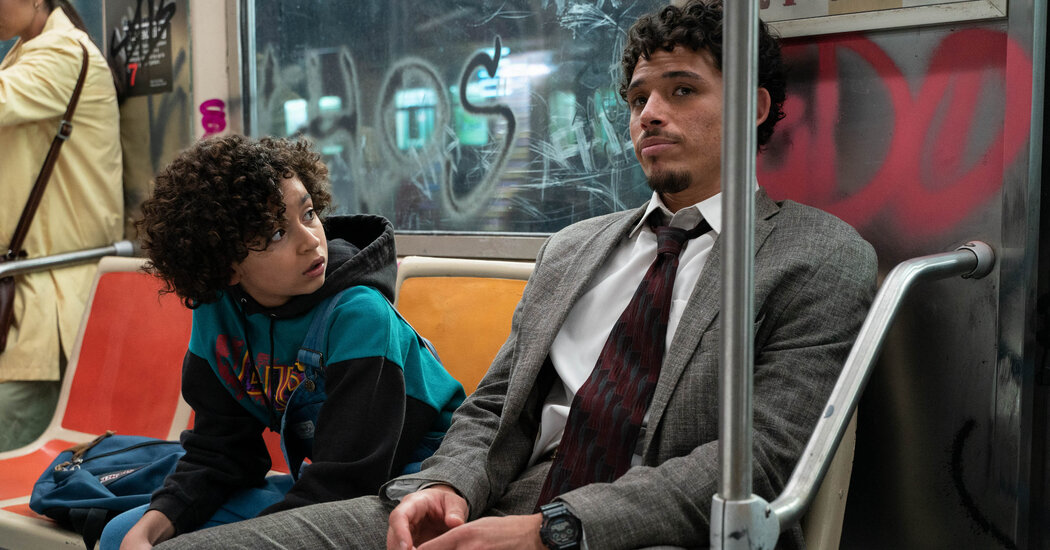
In previous “Transformers” movies, fans have seen their beloved robots Optimus Prime, Bumblebee and Arcee battle their way out of plenty a dilemma. But have they ever seen an Autobot kick butt to the rhymes of LL Cool J? That’s the energy of “Transformers: Rise of the Beasts” (in theaters), with its director Steven Caple Jr. giving the franchise an inclusive spin.
The down on his luck Brooklyn native Noah Diaz (Anthony Ramos) is recruited by the Autobots to retrieve an artifact held by the museum researcher Elena Wallace (Dominique Fishback) that could transport the stranded Autobots back to their home planet, Cybertron.
Robot fights ensue (mainly with a rival faction called the Terrorcons), but apart from the dazzling effects and globe-trotting backdrops, what gives Caple’s film its singular identity is the 1990s New York City hip-hop it takes inspiration from.
“The ’90s was a specific era, in general, that is definitely what we wanted to tap into with the film,” Caple said in an audio interview. A sense of Black cultural spirit — the fashion, music, and community — was one that Caple felt was missing from many big budget movies of that decade. He said that it was only present if you were watching films by Black directors like John Singleton and Ernest Dickerson, major influences for Caple.
To imbue the film with this nostalgic presence, the production first needed to transform a section of Montreal into Brooklyn. The effects of gentrification in Brooklyn were a factor that necessitated the move across the border. The team referred to the photography of Jamel Shabazz and the television series “New York Undercover” as visual touchstones to capture the city’s past aesthetics. They also scoured Montreal for a semblance of a street that could serve as Noah’s neighborhood, and populated the area with vintage Oldsmobiles, Cavaliers and an Acura Legend. A tracking shot near the film’s beginning creates a vivid reawakening of the era: Noah walks down the street past classic cars, and through scenes of people sitting on crates and drinking quarter waters, of some selling tapes out of their trunk.
Caple and the production designer Sean Haworth credited Ramos and Fishback — both New York natives — with providing notes that added to the film’s authenticity.
“They start bringing things that they remembered from their childhood,” said Haworth in an interview, “things they liked or the music they listened to, the books they read.”
Another texture from the ’90s arises in the film’s period-accurate fashions. Caple credited the costume designer Ciara Whaley with rewatching television shows like “The Fresh Prince of Bel-Air” and “Living Single” to inspire the fly look composed of chokers and suspenders for Fishback’s Elena. For Noah’s appearance, Caple wanted to draw from the decade’s popular clothing lines. “I was very specific in being like, I wanna work with the Karl Kanis and the Walker Wear, the gear we were pushing during that time, but also were Black owned,” he said.
While the film’s visual callbacks are imperative, it’s the hip-hop soundtrack that gives “Rise of the Beasts” its sonic verve. The music occasionally springs from diegetic sources. Fishback, for instance, suggested to Caple that Elena should sing to herself whenever she’s nervous. It’s why when the Terrorcons infiltrate Elena’s museum, she can be heard crooning TLC’s “Waterfalls” to herself.
At other times, a needle drop of a radio classic will propel a scene, such as Digable Planets’ “Rebirth of Slick (Cool Like Dat)” powering a heist sequence whereby Noah attempts to steal an Autobot disguised as a Porsche. Other soundtrack samplings include Black Sheep’s “The Choice Is Yours,” The Notorious B.I.G.’s “Hypnotize,” A Tribe Called Quest’s “Check the Rhime” and Wu-Tang Clan’s “C.R.E.A.M.” The music remains prominent even when the action shifts from the confines of New York City to the rolling hills of Peru. During the final battle between the Autobots and Terrorcons, LL Cool J’s “Mama Said Knock You Out” provides a sharp punch that put a dent in the film’s budget.
“It fits so perfectly, but the studio said this is gonna be the most expensive song in the movie,” Caple said. “It was that pricey. But it just felt so right.”
As did commissioning the soundtrack’s sole original song, “On My Soul,” by Tobe Nwigwe (who also stars as Noah’s friend Reek) and the hip-hop legend Nas, featuring Jacob Banks. The defiant track not only gives the final battle a firmer edge beyond the easy grooves of the throwback needle drops, it marries contemporary recording techniques with ’90s flair, particularly through Nas’s sharp verses. In an interview, Nwigwe said that Nas “came in and just cooked up greatness.”
To Caple, harnessing the ’90s hip-hop scene was more than artistically fulfilling. It’s a vision of urban Blackness that needn’t be politically important, even as it showcases a specific cultural lens of music and fashion. And while it’s easy to see “Transformers: Rise of the Beasts” as a bid for nostalgia, Caple doesn’t want to call it a comeback. It’s a resurgence.













